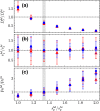Self-phoretic Brownian dynamics simulations
- PMID: 35303182
- PMCID: PMC8933386
- DOI: 10.1140/epje/s10189-022-00177-3
Self-phoretic Brownian dynamics simulations
Abstract
A realistic and effective model to simulate phoretic Brownian dynamics swimmers based on the general form of the thermophoretic force is here presented. The collective behavior of self-phoretic dimers is investigated with this model and compared with two simpler versions, allowing the understanding of the subtle interplay of steric interactions, propulsion, and phoretic effects. The phoretic Brownian dynamics method has control parameters which can be tuned to closely map the properties of experiments or simulations with explicit solvent, in particular those performed with multiparticle collision dynamics. The combination of the phoretic Brownian method and multiparticle collision dynamics is a powerful tool to precisely identify the importance of hydrodynamic interactions in systems of self-phoretic swimmers.
© 2022. The Author(s).
Figures





References
-
- Gompper G, Winkler RG, Speck T, Solon A, Nardini C, Peruani F, Löwen H, Golestanian R, Kaupp UB, Alvarez L, et al. J. Phys.: Condens. Matter. 2020;32(19):193001. - PubMed
-
- C. Bechinger, R. Di Leonardo, H. Löwen, C. Reichhardt, G. Volpe, Rev. Mod. Phys. 88 (2016)
-
- G. De Magistris, D. Marenduzzo, Physica A 418 (2015)
-
- M.C. Marchetti, J.F. Joanny, S. Ramaswamy, T.B. Liverpool, J. Prost, M. Rao, A.S. Simha, Rev. Mod. Phys. 85 (2013)
-
- S. Ramaswamy, Annu. Rev. Condens. Matter Phys. 1 (2010)
MeSH terms
Substances
Grants and funding
LinkOut - more resources
Full Text Sources

